Final report for ONE14-203
Project Information
Plants high in condensed tannins have been shown in numerous studies to help reduce the population of Haemonchus Contortus. This parasite can be a serious threat to small ruminant animals. Sericea lespezda and Big Trefoil Lotus uliginosus, also known as L. pedunculatus contain high levels of condensed tannins. They have been grown and used in the Southern United States for many years, but very little in the Northeast. This project evaluated the ability to grow these plants in the Northeast state of Maine and their ability to survive Maine winters as a perennial in pasture.
Planted at four sites we found four results over multiple plantings from 2014-2016. We were able to establish each plant, though sometimes very weedy, on all sites. While Sercecea Lespedeza failed to overwinter on three plots in mid-Maine, it did survive on the plot in southern Maine. Where Big Trefoil survived the winter, the yield was related to the weed pressure. We found it is very important to control weed pressure for success in establishing a stand either by plot preparation or removing weeds during establishment.
From this we recommend that farmers in Mid-Maine and southern Maine try to establish Big Trefoil to graze or harvest as a perennial crop. Only farms in southern Maine should try to use Serecea Lespedeza as a perennial crop and more northern farms could try it as an annual crop.
Introduction:
This project evaluate the the ability of these plants to perform as perennials in the Northeast of Sericea lespezda and Big Trefoil Lotus uliginosus, also known as L. pedunculatus and to determine productivity.
Using these plants for grazing in the Northeast has not been done, as it has in the South and Mid-Atlantic states. Both of these plants are tolerant of heavy wet soils and low pH, so they would be a propitious choice for farmers less than optimum soils and with limited opportunities for soil improvement. This project will be a chance to evaluate the ability of these plants to grow in the NE.
These plants have been shown to be high in condensed tannins, helping to control parasitism in a few ways. (Min, B.R., and S.P. Hart. 2003), [Tannins for suppression of internal parasites, Journal of Animal Science 81 (E. Suppl. 2):E102–E109 and Min, B.R., S.P. Hart, D. Miller, G.M. Tomita, E. Loetz,and T. Sahlu, 2005], The effect of grazing forage containing condensed tannins on gastro-intestinal nematode parasite infection and milk composition in Angora does, Veterinary Parasitology 151. p. 105–113. as quoted in the ATTRA publication Tools for Managing Internal Parasites in Small Ruminants: Sericea Lespedeza. This publication states;
Researchers have shown that big trefoil,… sericea lespedeza are useful in controlling internal parasite infection in sheep and goats. … boost the health of sheep or goats.
Sericea lespedeza is a high-tannin forage (4– 15% DM) that has been scientifically proven to reduce parasite loads in sheep and goats. … action is not yet known. Researchers believe that the plant tannins may affect parasites either directly or indirectly (or both). … react directly with adult worms by attaching to their “skin”, causing them distress, or indirectly by improving protein nutrition of the goat and boosting the immune system. … reduce the hatching of fecal eggs and development of larvae, perhaps by binding to the larvae. (Min et al., 2005). The tannins could also bind with feed nutrients and possibly prevent bacterial growth in the feces (larva feed on bacteria) and so limit the feed available for larval growth, or in some other way inhibit larvae growth and movement. Adult worms residing in animals … grazing sericea … shed fewer eggs, … reduced hatching ability. However, when animals are moved off sericea lespedeza pastures and on to other forages, egg counts go back up, indicating that mature worms were inhibited but not killed …. As animals are fed with sericea for longer periods of time, research has shown a reduction in mature worms as well (Min et al., 2005, Shaik et al., 2006, Lange et al., 2006).
This project sought to evaluate the the ability of these plants to perform as perennials in the Northeast: of Sericea lespedeza and Big Trefoil Lotus uliginosus, also known as L. pedunculatus and to determine productivity in the form of biomass harvest. If they can be established, they will be grazed or harvested by hand to measure biomass production.
Cooperators
Research
At cooperating farms, 1/2 acre strips of trefoil and lespedeza were set aside to be tilled and broadcast seeded at the 4 lbs./acre and 25 lbs./acre, respectively. The plan was for farms to also graze the strips for 1-3 days depending on the plant population. To complement this, lantings were also done at MOFGA’s Common Ground Education Center. We had hoped to measure biomass production with .25 meter sq. plot sample harvesting on the same schedule as the grazings. We used randomized complete block design in 10’x10’ plots of each species alone and each in combination with perennial rye.
At the cooperating farms, Little Falls Farm in Harrison and Hamilton Farm in Alna, 1/2 acre strips of trefoil and lespedeza were tilled and broadcast seeded at the 4 lb./acre and 25lbs./acre rate. When possible, with good establishment, the cooperating farms grazed the strips for 1-3 days depending on the plant population. Impact was limited to avoid killing the crop. One farm grazed two times during the grazing season. Harvests were planned for July 15 and August 15, with some flexibility depending on the viability of the plantings. On the second year the grazings were done on June 15th, July15th and August 15th.
Plantings were done at MOFGA’s Common Ground Education center, using randomized complete block design. We planted 10’x10’ plots of each species alone and each in combination with perennial rye. The control plots were perennial rye. This project intended to evaluate biomass production with .25 meter sq. plot sample harvesting. Dry Matter levels will determined by drying the samples in the microwave..
The big trefoil was seeded at 4 lbs/acre, lespedeza at 25 lbs/acre.
In 2014;
On Little Falls Farm (Harrison, Maine) ½ acre plots were planted, 5/14/14 tilled area to be seeded. 5/15seeded lespedeza and trefoil by hand. 5/15packed seed in with Brillion seeder. Mid June, mowed both, Mid August, mowed both, Spaded part of each planting.
On Hamilton Farm (Alna, Maine) 1/8 acre area was planted, 5/14, and 28 Tilled area to be seeded 6/1/14 Seeded lespedeza and trefoil by hand.
On the MOFGA Common Ground Fair site (Unity, Maine) the plots described above were planted.
5/28 Tilled and cultivated, 6/2 Tilled and cultivated, 6/6 Tilled and planted buckwheat, 6/27 Tilled in buckwheat, 7/7 planted planted lespedeza and trefoil.
In 2015;
On Little Falls Farm added more ground for 2015. 1/4 acre of lespedeza planted was planted at double the original seeding rate, May 2015 harrowed twice, July 15, lightly harrowed to prepare seedbeds, July 16, Seeded sericea lespedeza, July 21, Seeded sericea lespedeza.. No trefoil seed was supplied in 2015, mistakenly.
On Hamilton Farm 100x110 foot for each crop acre was planted at double the original seeding rate, 7/2/2015, and 28 Tilled area to be seeded, 7/15/14 Seeded lespedeza and trefoil by hand.
On the MOFGA Common Ground Fair site the plots as described were planted. 7/6/2015 Tilled and cultivated, 7/2 Tilled and cultivated, 7/7 planted planted lespedeza and trefoil with rye into 10x10plots.
In 2016;
On the MOFGA Common Ground Fair site the plots described above were planted. 6/20 planted lespedeza and trefoil with rye into 10x10plots.
On Noon Family Sheep Farm (Springvale, Maine) 10x10 plots were planted with the remaining seed on 8/1, approximately one ounce of each. Jean Noon also did some test pots to test the seed.
2014 plantings and 2015 survival results;
Table 1. Establishment success and survival at of Big Trefoil and Sercea Lespedeza plantings at 3 sites in 2014-2015.
| Est. 2014 | Est. 2014 | survived 2015 | survived 2015 | |
| Location | Big Trefoil | Serecea L. | Big Trefoil | Serecea L. |
| MOFGA | yes | yes | sparse* | sparse* |
| Little Falls | yes | yes | 50% | no |
| Hamilton | yes | yes | sparse* | sparse* |
*these plots were very weedy
At Little Falls Farm;
In early July mowed all of it to knock down the weeds and especially virginia copperleaf. After a week or two both plantings re-grew and again the copperleaf was more competitive. August, about 2/3 of the Trefoil and 1/2 of the lespedeza was tilled in(areas with the worst copperleaf). I kept the cleanest, (being a relative term!) sections of each. Mowed again early August and both plantings seemed OK, although weedy. Frost killed off the copperleaf left 1/4 acre of lespediza and perhaps an 8th of trefoil to see if they overwinter. .
50% of the trefoil survived and none of the lespedeza.
The plantings at Hamilton farm and MOFGA were very sparse. But considering the weed pressure in both of those plantings it was not surprising.
2015 plantings and 2016 survival results;
Table 2: Establishment success and survival at of Big Trefoil and Sercea Lespedeza plantings at 3 sites in 2015-2016.
| Est. 2015 | Est. 2015 | Survived 2016 | Survived 2016 | |
| Location | Big Trefoil | Serecea L. | Big Trefoil | Serecea L. |
| MOFGA | yes | yes | sparse* | no |
| Little Falls | yes | yes | yes (grazed) | no |
| Hamilton | yes | yes | sparse* | no |
* weedy plots
Little Falls Farm;
The plantings of lespedeza and big trefoil that was replanted both germinated well and established a good stand. They were grazed twice and enjoyed by the goats! Pictures are included.
The lespedeza didn't like the frost. It turned brown over a period of a week.
The surviving planting at Hamilton farm of big trefoil was very sparce. But considering the weed pressure it was not surprising. This area was tilled-in. The new plots planted germinated marginally well. Again it was heavily impacted by weeds and the drought.
The planting at MOFGA was tilled-in spring 2016 and another planting was attempted. Because of the drought, no lespedeza germinated and only a few clumps of trefoil. Photos are included. The planting at MOFGA were exhibited at the Common Ground Country Fair with a sign describing the project.
2016 to 2017 winter survival results;
Table 2: Establishment success and survival at of Big Trefoil and Serecea Lespedeza plantings at 2 sites in 2016-2017.
| Est. 2016 | Est. 2016 | Survived 2017 | Survived 2017 | |
| Location* | Big Trefoil | Sececea L. | Big Trefoil | Serecea L. |
| MOFGA | yes | no | sparse | no |
| Noon Farm | yes | yes | yes (grazed) | yes (grazed) |
*Little Falls and Hamilton Farm ended the study so there was not data.
Little Falls farm tilled-in the plots this spring because of the weed pressure and needing the field for other production.
Hamilton Farm had survival of both 2014 and 2015 seedings of the big trefoil. The 2014 plot was more sparse than the 2015 plot. But the fact that it survived at all was surprising since it had been tilled. It appeared that the 2015 and maybe the 2014 areas were seed that had overwintered. No lespedeza survived.
Noon Family farm had survival of both the lespedeza and big trefoil! Very exciting outcome. It was grazed again by the young lambs. It did not result in thick stands due to pressure from competing plants but it did survive and flower. So it appears that there is some potential for growing both plants for parasite control for the sheep and goats in southern Maine.
The plots on MOFGA's Common Ground site had a few concentrated small areas of big trefoil that like at Hamilton farm were seed that had overwintered and germinated. No lespedeza survived. Unfortunately, the area will be used for another purpose in 2017 so it will be tilled in. At the MOFGA site, we never got enough germination to justify doing any cutting and measuring of dry matter production in the test plots. So that part of the proposed research was not accomplished.
Every planting was heavily impacted by weed pressure. Little Falls farm had been a cover crop area planted in oats the year before and the primary weed was virginia copperleaf. This weed must have come with the oat seed since it was never seen on the farm before. Hamilton farm was planted on newly tilled ground and also had a variety of weeds.The MOFGA area had been in hoop house production for the previous 4 years, there was a wide variety of weeds. The plants at Noon Family farm were tilled in pasture ground.
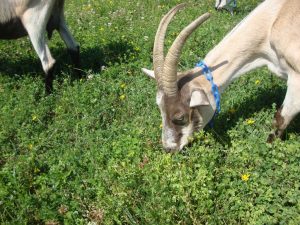
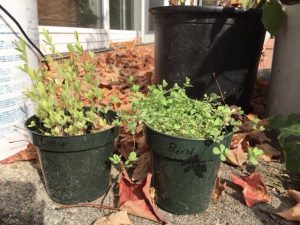
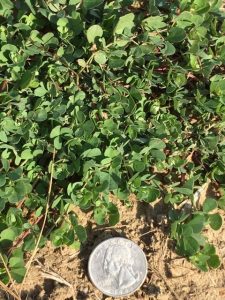
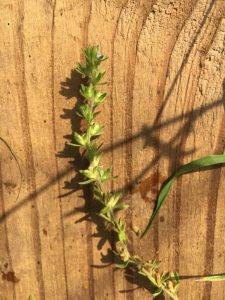
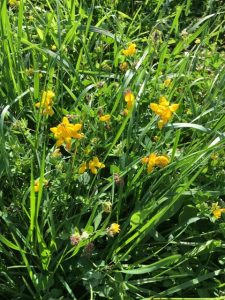
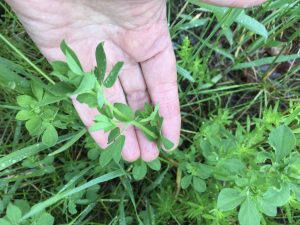
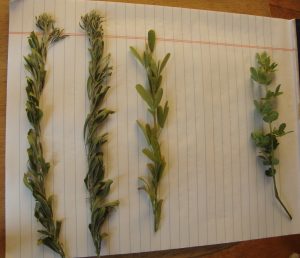
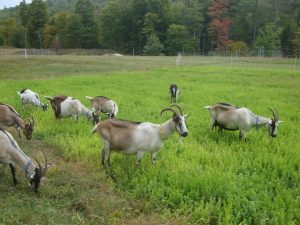
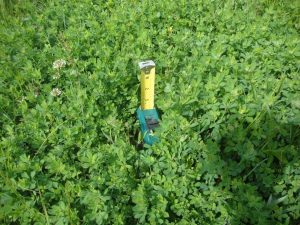
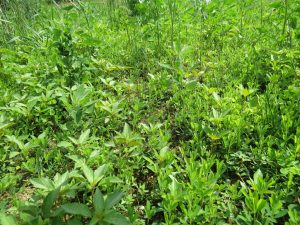
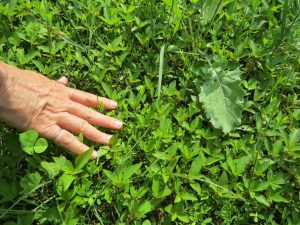
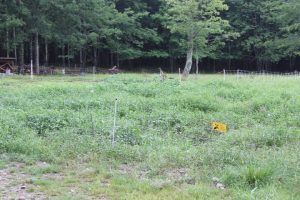
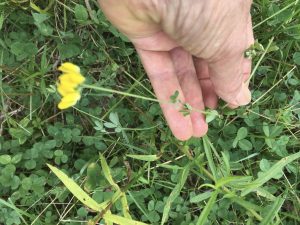
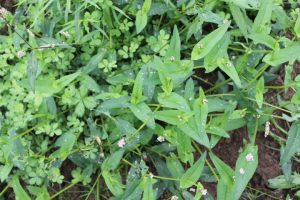
It became very obvious that because of the very small seed size of both the big trefoil and lespedeza, the impact of weed pressure can be very significant. It is important to have a clean, well prepared, firm seed bed in order to get good growth of either plant. It would also be very helpful to roll the plot after seeding to improve soil to seed contact, if seeding by hand or using brillion seeder.
Big trefoil is more likely to survive the winter cold in midcoast to southern Maine. The lespedeza has potential to survive in southern Maine.
We answered the question of the project about survivability and what is need to be done to improve success for planting Serecia Lespedeza and Big Trefoil. For farmers that would like to use lespedeza for parasite prevention in areas other that southerm Maine they will have to purchase the hay or pellets that are available from the southern states. It is possible that farmers in midcoast and south would be able to plant big trefoil with success as a perennial. This would help farmers to control the populations of Haemonchus contortus in sheep and goats at a lower cost than having to purchase lespedeza.
The seed for both the big trefoil and lespedeza are very small and need a very clean seed bed in order to be successful. Unfortunately none of the plantings we did were into appropriately weed seed free sites. Also the drought in 2016 seriously reduced germination.
It was encouraging to see the dormant trefoil seed germinate in 2017 despite serious competition and drought in 2016.
Big Trefoil has potential for planting in the northeast, since it will survive wet, poorly drained low ph soils. It acturally has higher tannin levels when grown in lower fertility soils as explained in Kaiser, C.J. and M.E. Heath. 1990. Big trefoil: A new legume for pastures on fragipan soils. p. 191-194. In: J. Janick and J.E. Simon (eds.), Advances in new crops. Timber Press, Portland, OR.
I recommend that farmers in mid-Maine try to establish plantings of Lotus uliginosus, given the seed survival and germination rate. Sericea lespedeza survived in Southern Maine but must be used as an annual in mid-Maine and farther north. Organic farmers seeking the benefits of lespedeza for their livestock will have to raise their own; conventional farmers can buy it as pellets and hay. Some people are concerned that lespedeza can become invasive, as it has in areas of the
Midwest and South.
Education & Outreach Activities and Participation Summary
Participation Summary:
We had an article summarizing the study published in the September 2017 MOFGA Newsletter.
Learning Outcomes
Realization that the Big Trefoil will reseed itself and survive in Mid Maine climate, but Lespedeza will only survive in Southern Maine.
Project Outcomes
Two of the three farmers will continue to use the surviving plants for grazing and parasite control
With the positive results of establishment and survival of both Big Trefoil and Lezpedeza at some of the sites under poor conditions, both weed pressure and drought, we are optimistic that these species can be established in Maine. We would hope that someone with good tillage practices in central to southern Maine would now try to grow these crops for harvest or for grazing.
Information Products
- Evaluating Sericea Lespedeza and Big Trefoil as Perennial Forage Crops in Maine (Article/Newsletter/Blog)